René Walling
QuébecSF
Author Note
Correspondence concerning this report should be addressed to René Walling.
Contact: [email protected]
Report: Worldcon Membership Demographics, 1939-1960
Purpose
Sweeping statements and generalizations are often made about the membership of early World Science Fiction Conventions (WSFC, or Worldcon) such as “only the same people came back every year” or “the attendance was all male.” Yet rarely is more than anecdotal evidence given to support these statements. The goal of this report is to provide some hard data on the membership of early Worldcons so that such statements can be based on more than anecdotal evidence.
Methodology
Fundamental Membership Data
The membership lists published in the WSFC sources for any given Worldcon, which consist of progress reports and program books, were compiled in one database indicating each person’s name and which Worldcon(s) they were a member of. The exception is the 1941 Worldcon, for which the names mentioned in a convention report by Rusty Hevelin and an article in the Denvention II Program Book were used. All data sources used are listed in Appendix A in chronological order by Worldcon.
Since the names listed in the progress reports and program books are only for those people who registered ahead of time, it is thus to be expected that the total number of names from WFSC sources does not match the total membership as reported in the Long List of World Science Fiction Conventions (hereafter the “Long List”), also referenced in Appendix A. In addition the Long List is based on a variety of documents, mostly fanzine and other convention publications, and most fans reporting on Worldcons at the time focused on the number of attendees – people who were physically present at the convention, not the number of members – people who purchased memberships to the convention in order to receive its publications by mail. It is also important to note that, for the same reason, the sample studied is not randomized.
Repeat Members
For data analysis spanning multiple Worldcons, the assumption is made that a name that appears in different membership lists always refers to the same person.
Obvious “joke” names are eliminated and multiple known pseudonyms for the same person appearing in a single Worldcon’s membership list – a well known example is Forrest J. Ackerman who appears several times in the membership lists for the 1939 convention, Nycon I – are eliminated for the purposes of this study.
Gender identification
Gender determination based on name is commonly used to extract the otherwise unavailable data from lists of names. Three different methods were used to do so. For all of them, gender was first assigned based on honorifics. In addition, members who only had first name initials listed, as well as organizations and other non-human entities were assigned a gender of “Other.”
Method 1. The first method consists of consulting several websites (Behind the name, n.d.; Meaning of names, n.d.; Names, n.d.) on the meaning of names and assigning gender according to the gender listed in the website. In the case of names unlisted in any of these sites “Other” was selected as the gender. The same was done with gender neutral names.
Method 2. The second method is to run the list of names through the Genderize.io (Genderize, n.d.) application-programming interface (API.) Since Genderize provides a probability factor for the gender of each name, this can be used to assign a weighted estimate for gender neutral names. Names where the API returned a result of “null”, meaning they are not in the database consulted by the API, were labeled “Other”. If the gender of a specific person is known, it was assigned a probability of 100%, regardless of the result give by the API. The advantage of this method over method number three outlined below is that genderize.io incorporates not only first names, but also common nicknames, e.g. Jim, Pat, Liz, etc…
Method 3. The third method is to do a statistical analysis using the genderdata package (Mullen, 2015) for R (a statistical analysis software.) In addition to assigning a weighted estimate for gender neutral names, like the Genderize.io API, it also takes the estimated year of birth of each person into account. The downside is that for the time period concerned only data for the United States is available. This is mitigated by the fact that the large majority of Worldcon members at the time were from the U.S. This is supported by the souvenir books of some of the Worldcons that published membership maps, as well as some articles published at the time: an article on the Big Pond Fund in the Philcon News #1 (Ackerman, 1947) mentions that in the first four Worldcons no one from outside the U.S.A. had attended; the membership of the 1949 convention included 14 members from Canada and two from the United Kingdom; finally, the 1957 convention, Loncon I, held in London, England, had a membership list with 281 members listed as from the U.S. out of 482 members, so even overseas, Americans were in the majority. For year of birth, as the package can provide a gender estimate for a range of years, it was assumed that members registered for their first Worldcon between the ages of 18 and 40, inclusively. Again, if the gender of a specific person is known, it was assigned a probability of 100%. If the package did not return any results, meaning a name was not in the database consulted, it was assigned a gender of “Other”.
Results
The number of members listed over the entire 1939-1960 time span totals 5602 for the WSFC sources, which represents 75.47% of the total from the Long List (7391). The total number of individual members is 3254.
Table 1 presents membership data for every year a Worldcon was held between 1939 and 1960 inclusively. The first column shows the number of members according to the Long List. The second column shows the number of members compiled for this report from WSFC sources.
Figure 1 compares the yearly totals of the WSFC data (column 2 of Table 1) to those of the Long List (column 1 of Table 1). What can be seen immediately, is that for 1946, 1949 and 1957, the numbers of names listed exceeds that of the estimated number of attendees. The same is true to a lesser extent for 1951 and 1955. This is likely because it was common for people to purchase a membership in order to support the convention, receive convention publications by mail, and not attend – this is referred to as a Supporting Membership and is a practice that continues to this day. The year with the smallest proportion of names listed is 1950, which can probably be explained by the fact that only Progress Report 1 was available at the time of this survey.
Table 2 details the same WSFC data as a function of the number of Worldcons attended up to that point in time by members each year. We can then compile these numbers to know how many people attended only one Worldcon in the period surveyed, how many attended two, and so on. This compilation is done by looking at how many members return in a given year and which ones do not. To give an example, of the 105 people who attended the 1939 Worldcon, 21 also attended the 1940 Worldcon, 84 chose not to, and 75 new people attended their first Worldcon in 1940. So after the second Worldcon, the number of members who have attended two Worldcons is 21, and the number of one time members is:
105 – 21 + 75 = 159
Similarly after the 1941 Worldcon number of members who have attended three Worldcons is 7, the number of members who have attended two Worldcons is:
21 – 7 + 16 = 30
and the number of one time members is:
159 – 33 + 56 = 182
And so on.
The compiled results, shown in the last line of table 2, shows us that a large majority of Worldcon members only attended a single Worldcon, and the number of members goes down rapidly as the number of Worldcons attended increases and seems to follow an inverse logarithmic curve.
Figure 2 compares the number of first-time members (Column 3 of Table 2) to the total of the WSFS data (Column 2 of Table 2).
Table 3 compares first time members to the total of the WSFS data. Figure 3 shows the ratios listed in Column 4 of Table 3.
In Figure 2, we can immediately see that, in general, the larger a Worldcon’s membership was, the more new members it attracted. In fact the correlation coefficient between the two is high enough (0.93) to say there is a direct relationship between the two. We also see an upward trend in the total number of members. In Figure 3 we can see that the overall proportion of new members is trending downwards. This is to be expected as the pool of previous Worldcon members grows larger every year. The Worldcons with the largest percentage of first time members are the 1939 and 1940 conventions – the first two, so no great surprise there – the 1946 convention which followed a 5-year hiatus and the 1952 convention – the largest one in the period surveyed. The 1957 Worldcon also shows a larger percentage of new members when compared to the ones that immediately precede and follow it, which can be explained by the fact that it was held in London and therefore many European fans who had not been able to do so before were able to attend for the first time.
Table 4 shows the gender breakdown of each convention by year for all three gender determination methods used, as well as the averages (columns 4, 9 and 14 of Table 3) and standard deviations (columns 5, 10 and 15 of Table 3) for each value. The values given by the three methods are statistically close enough to be able to average them and use the standard deviation as the margin of error on the results.
Figure 4 shows us the gender balance by year using this average. We can see a general downwards trend in the proportion of male attendees and that, with the exception of 1939, all Worldcons before 1950 have a smaller proportion of female members than all subsequent ones.
Table 5 shows the gender breakdown as a function of the number of Worldcons attended. The first thing that can be seen is that the number of people who attend a given number of Worldcons goes down as the number of Worldcons attended goes up. This approximately follows an inverse logarithmic curve.
As the number of members who attended nine or more Worldcons is very low, these cannot be used as a statistically significant sample, but the remaining members, i.e. those that have attended eight of fewer conventions can be. Figure 5 gives us the same data in graph form for members who attended 8 or fewer Worldcons. It clearly shows that the more Worldcons someone has attended, the more likely they are to be male.
In brief we can observe the following things:
- Worldcons at the time attracted a sizeable number of new members every year.
- The size of Worldcon memberships can vary unpredictably from one year to the next.
- Punctual events – everything from WWII to the location of a Worldcon – affect the membership of one or two Worldcons rather than all of them from that moment on.
- Changes in the composition of Worldcons memberships tend to take place over time.
Finally, it must be noted that the tables and charts presented reflect observations on the population of Worldcon memberships from 1939 to 1960, but do not explain on their own why any variations observed happened. In other words, they reflect the effect of events and not the cause of them. For this, further research would be needed. Questions of interest include:
- What major events in and out of fandom affected the membership of Worldcons both in terms of size and composition?
- Do what extent did the location of a Worldcon affect the size and composition of its membership?
- Why was the gender balance of the 1939 Worldcon so different from the ones that followed it?
- Why was the 1952 Worldcon so big compared to the ones that precede and follow it? According to the Long List, it will take another 15 years before a Worldcon reaches membership numbers above 1000 again.
- Does the size and composition of a Worldcon’s organizing committee bear a relationship to the size and composition of its membership?
- Does the number of program participants (panelists) and their composition bear a relationship to the size and composition of the membership of a Worldcon?
- Do any trends observed continue in subsequent Worldcons?
Appendix A
Data sources by Worldcon year
Convention, city and year
Sources
Nycon I
New York
1939
Official Souvenir Journal of the 1939 World Science Fiction Convention. (1939, July). 2.
Harris, Colin. (2013, November) Where’s Forry? Journey Planet, 17, 14. Retrieved from http://efanzines.com/JourneyPlanet/JourneyPlanet17.pdf
Chicon I
Chicago
1940
Chicon Program Booklet. (1940, September). Inside Front Cover.
Denvention I
Denver
1941
Hevelin, Rusty; Denvention I – Report. (1941). Retrieved from http://fanac.org/worldcon/Denvention/w41-rpt.html
Denvention One Membership Update. Denvention II Programme Book (1981). 99-100.
Pacificon
Los Angeles
1946
Pacificon Program Book. (1946, July). 1, 40.
Philcon I
Philadelphia
1947
Philcon News #2. (1947, February). 5-6.
Poor Richard’s Almanach, Issue 3 (The Millenium Philcon Progress Report 3. (2000). 17.
Torcon I
Toronto, Canada
1948
Torcon Program Book. (1948). 3.
Cinvention
Cincinnati
1949
Cinvention Program Book. (1949). 2-3.
NorWesCon
Portland, OR
1950
NorWesCon Progress Report 1. (1950). 6-8.
Nolacon I
New Orleans
1951
Nolacon 1 Bulletin 1. (1951, March). 7-9.
Nolacon 1 Bulletin 2. (1951, July). 6-7.
TASFiC
Chicago
1952
TASFIC Progress Report 1. (1952, January). 9-10.
TASFIC Progress Report 2. (1952, March). 4-5.
TASFIC Progress Reports 3. (1952, June). 6-7, 15.
TASFIC Progress Reports 4. (1952, August). 7.
Philcon II
Philadelphia
1953
Philcon II Program Book. (1953, September). 7, 9, 11, 13.
SFCon
San Francisco
1954
SFCon Progress Report 1. (1954, January). 5.
SFCon Progress Report 2. (1954, April). 5.
SFCon Progress Report 3. (1954, June). 6.
SFCon Progress Report 4. (1954, August). 2.
Clevention
Cleveland
1955
Clevention Progress Report 1. (1954, December). 10
Clevention Progress Report 2. (1955, February). 13.
Clevention Progress Report 3. (1955, May). 12.
Clevention Progress Report 4. (1955, July). 15.
Nycon II
New York
1956
Journal of the World Science Fiction Society. (1956, February). 14(1). 12.
Journal of the World Science Fiction Society. (1956). 14(2). 5
Journal of the World Science Fiction Society. (1956, June). 14(1). 22.
Loncon I
London, England
1957
Journal of WSFS. (1957). 15(1). 6-8.
Journal of WSFS. (1957, May). 15(2). 11.
Journal of WSFS. (1957). 15(3). 14-15.
Loncon Programme Book. (1957, September). 29.
Solacon
South Gate, CA
1958
Journal of the World Science Fiction Society.(n. d.). 16(1). 4-5, 7-8.
Journal of the World Science Fiction Society.(1958). 16(2). 8.
Journal of the World Science Fiction Society.(1958). 16(3). 14-15.
Detention
Detroit
1959
Detention Progress Report 1. (1958, December). 11, 13.
Detention Progress Report 2. (1959). 8-9.
Detention Progress Report 3. (1959). 12.
Detention Progress Report 4. (1959). 8.
Pittcon
Pittsburgh
1960
Pittcon Program Book. (1960). 44-48.
The Long List of World Science Fiction Conventions (Worldcons). Retrieved from http://www.smofinfo.com/LL/TheLongList.html
References
Ackerman, F. J. (1947). Make This Really a World Convention. Philcon News, 1, 5.
Campbell, M. (n.d.) Behind the name: The etymology and history of first names. Retrieved from
http://www.behindthename.com
Genderize. (n.d.) Retrieved from https://genderize.io/
Meaning of names. (n.d.) Retrieved from http://www.meaning-of-names.com/
Mullen, L. (n. d.). genderdata: Historical Datasets for Predicting Gender from Names. R package version 0.5.0. https://github.com/ropensci/genderdata
Names. (n.d.) Retrieved from http://www.names.org/
R Core Team (2015). R: A language and environment for statistical computing. R Foundation for Statistical Computing, Vienna, Austria. https://www.R-project.org/.

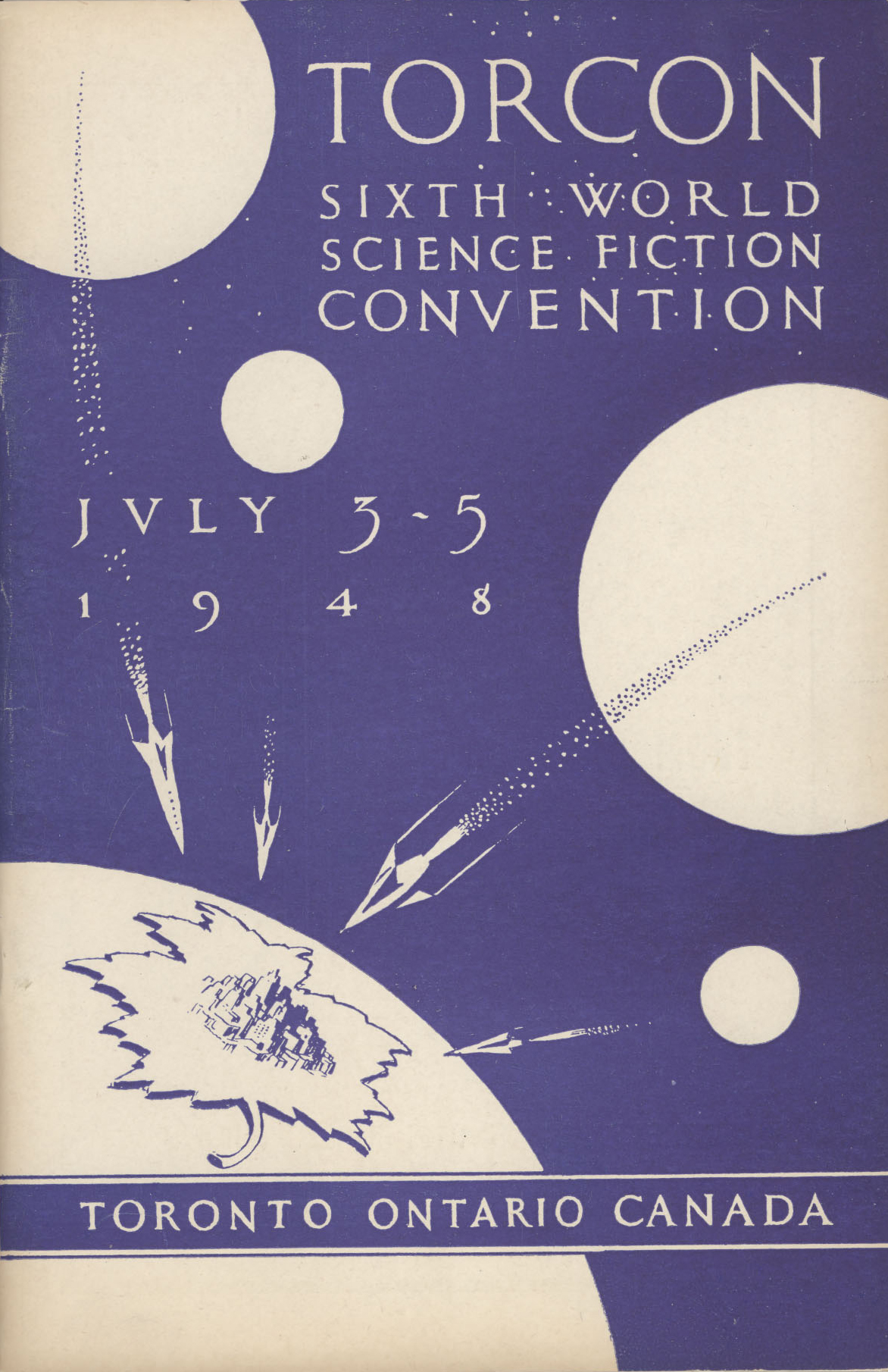
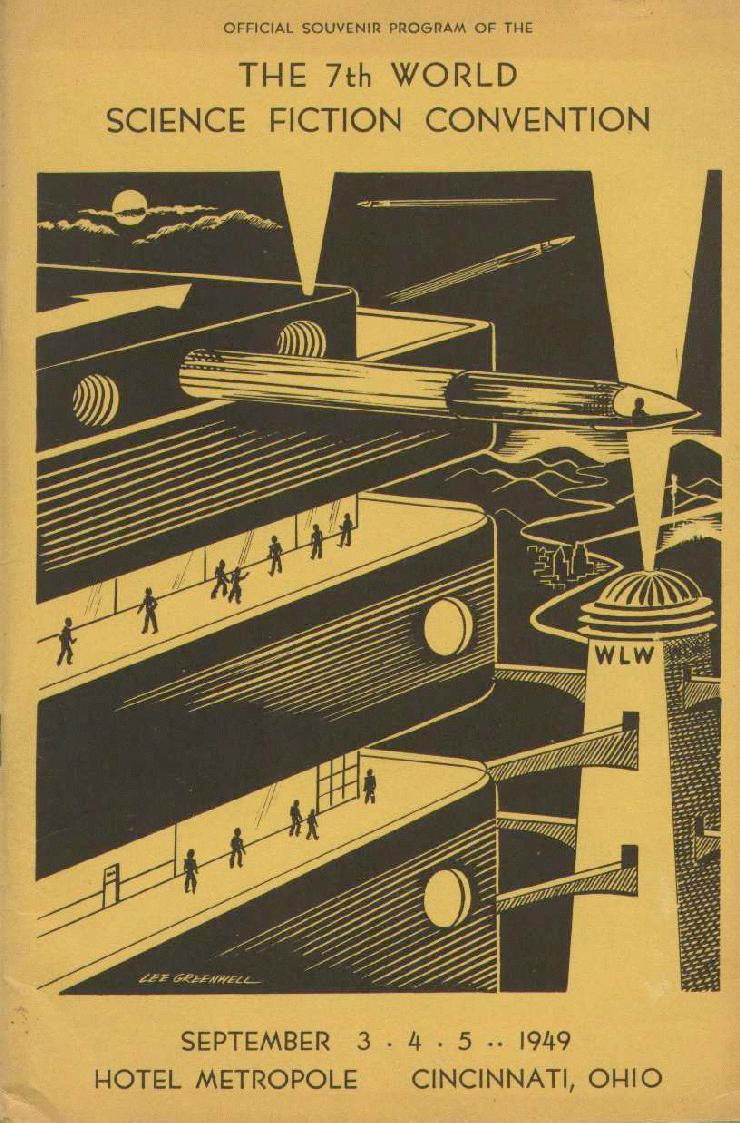
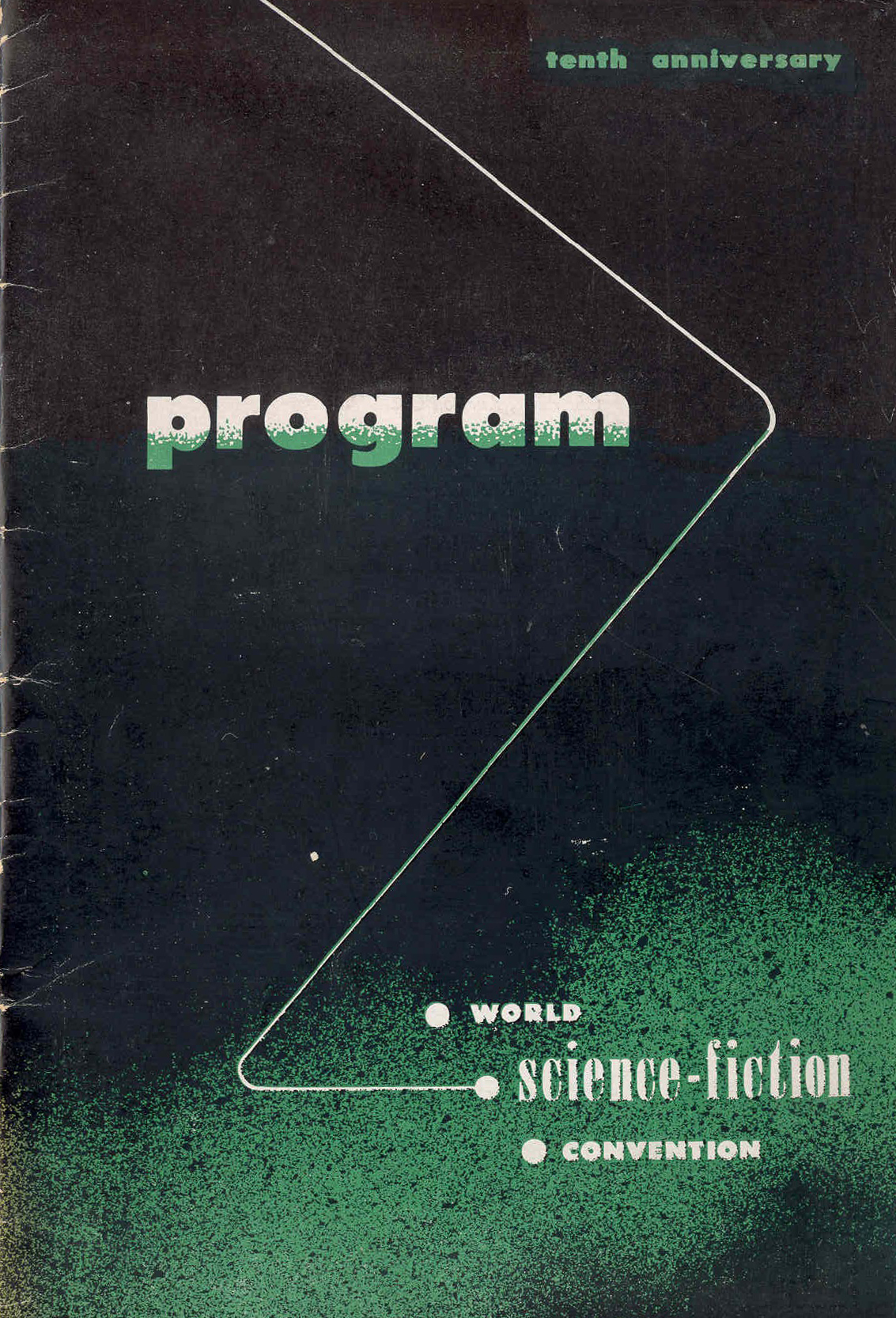
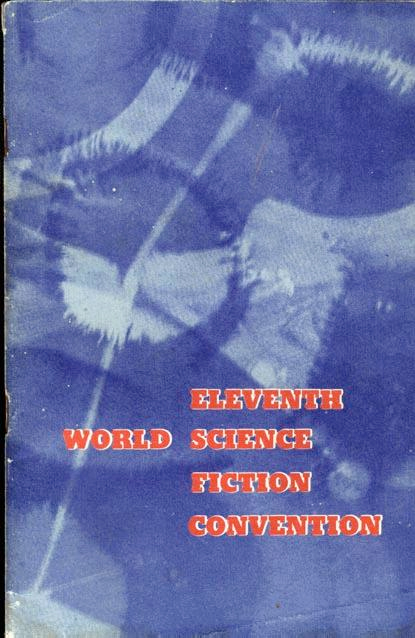
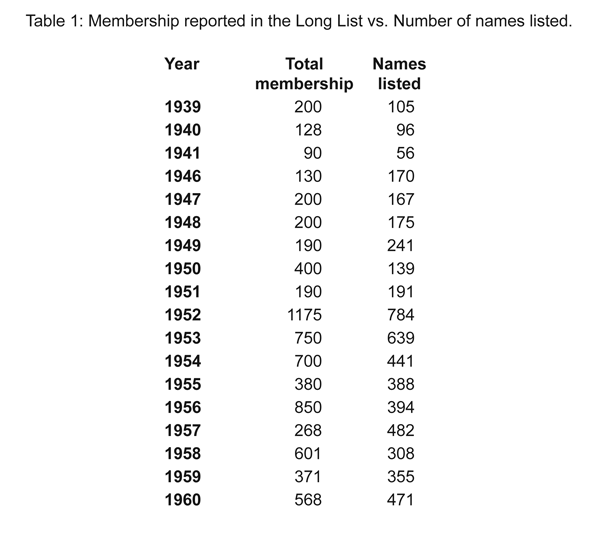

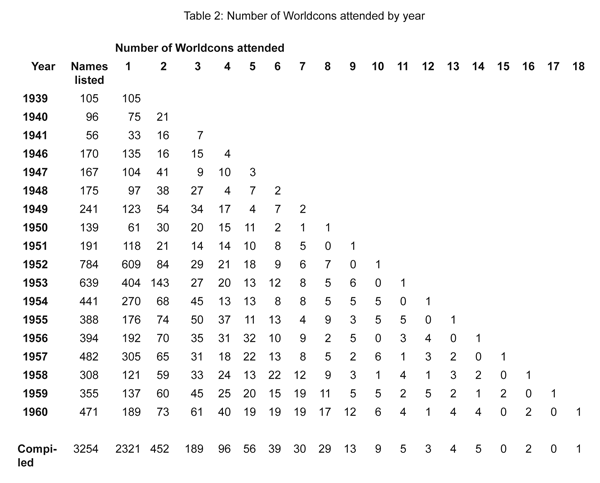

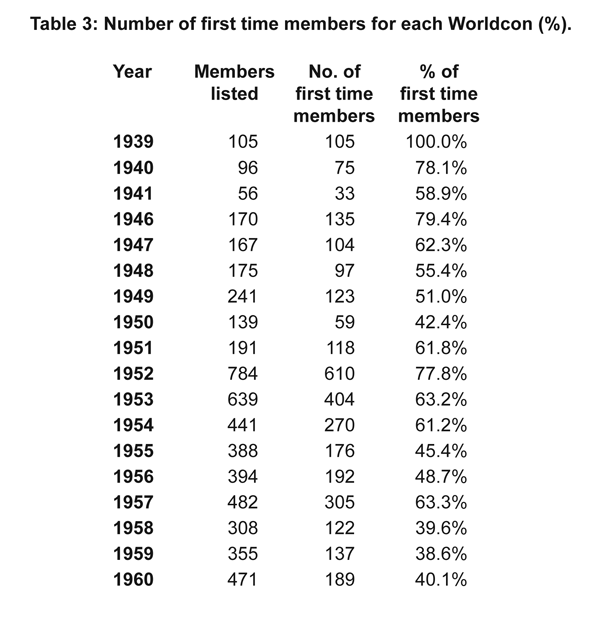

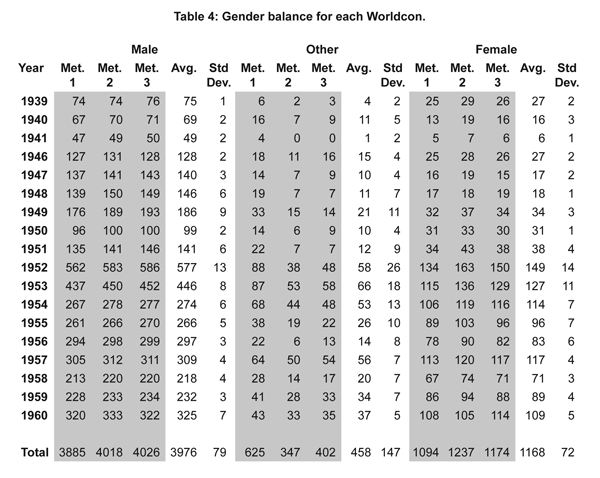

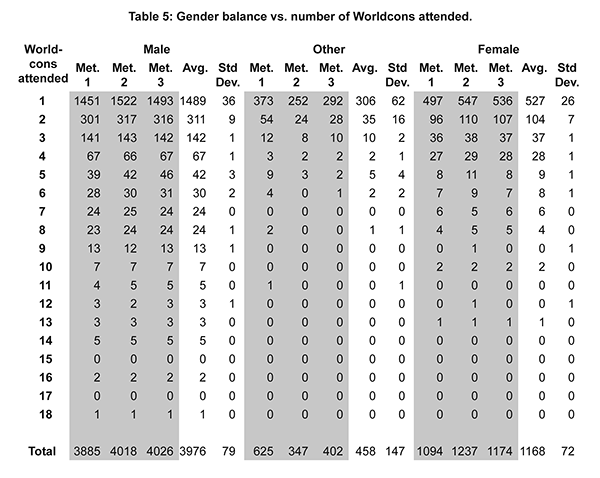

Leave A Comment